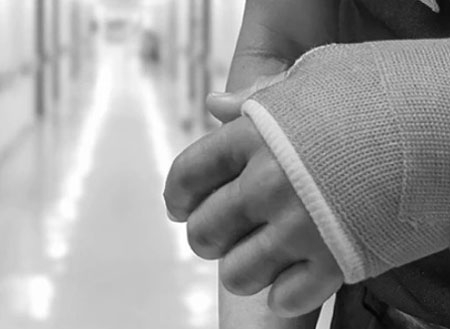
Casting and splinting is common practice in the world of orthopaedic care, though not quite as common as twenty years ago. Nowadays, early mobilization while still protecting the site of injury is the typical treatment regimen. With that being said, colorful fiberglass structures leave our office on a regular basis.
A typical cast consists of a stockinette to protect the skin, synthetic cotton padding to provide comfort, and several layers of fiberglass coated in resin to create a hard, sturdy, immobilizing structure. A splint is similar but the hard, outer layer is made of plaster rather than fiberglass. A splint is used after initial injury or surgery when the affected site has significant swelling. A unique feature of a splint is that it is not circumferential, so as your swelling ebbs and flows, it has somewhere to go rather than building up and creating a pressure that could cause discomfort and eventual damage while constricted in an unforgiving cast. Casts can be applied to any extremity and can vary in length and position depending on the diagnosis and goal of treatment.
Cast care is basic in theory: avoid getting it wet, avoid shoving anything in it to scratch that darn itch, and avoid knocking it on anything or anyone with too much force. Casts should be left alone and not used as a built in fidget-spinner. Patients should refrain from placing objects inside the cast for safe keeping as well.
Patients often ask about waterproof casts. Water-resistant casting supplies do exist, but have to be specifically ordered by your doctor. They are not used for any fracture that is determined to be unstable because despite their water-resistant nature, they do eventually break down and lose their integrity. They also are not used after a surgery when an incision is present because the incision needs to remain dry so it can heal without infection.
Cast claustrophobia is one of the issues we see regularly in our patients. It is not uncommon to experience some anxiety due to the feeling of constriction and immobilization that casts provide. We will do our best to accommodate your requests and provide reassurance, but we also have to treat your injury and return you to full function. Help us help you by communicating your concerns and trusting that your doctor has your best interests in mind.
We know casts are no fun and apologize for the great inconvenience, but we are looking out for your health and long-term well-being. Unfortunately, casts are one of the necessary evils of our world. We do the best we can to ensure your comfort during your time in the cast. With all of that being said, if a cast is causing significant and/or visible discomfort in the form of a sore, rash, or other irritation of the skin, we want to know immediately. We strive to apply comfortable, durable casts, but sometimes skin irritation can happen. Patients who have wounds on the skin underneath the cast often require some kind of monitoring during their time in a cast. Patients who have diabetes and the elderly demographic are at a higher risk of developing sores underneath the cast that can subsequently become infected and lead to further issues. We will certainly treat these issues and exchange casts accordingly, but our overall goal is to leave
casts in place for the duration of treatment so your injury has the best possible chance at healing appropriately.
When gravity gets you down and fractures result, come see us at Orthopaedic
Associates of Wisconsin in Pewaukee! Walk-in appointments for fractures are welcome!
This blog is written by one of our very own-Morgan. She is a certified athletic trainer working as a medical assistant with our providers each and every day in our clinic. She obtained a bachelor's degree in athletic training from Carroll University in Waukesha and a master's degree in Kinesiology from Michigan State University. She is excited to bring you updates and information about the happenings at OAW.

